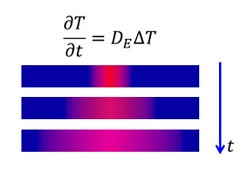Wandering heat: Anomalous heat distribution in one-dimensional systems

Uniform spreading of heat ceases in low dimensions<br>
Just as ember spreads through a piece of coal, heat principally diffuses at a constant rate. The corresponding physical law known as Fourier’s law was already established 200 years ago.
Later, scientists came to the conclusion that other rules must apply to the distribution of heat in two- or one-dimensional objects such as films or very fine wires. Respective evidence was provided, for example, by experiments with carbon nanotubes or organic molecular chains, where thermal conductivity was not only dependent on the object’s material but also on its size, or rather its length.
This means that in some materials thermal conductivity increases with the object’s length, while in others it decreases. However, no one has so far been able to derive a physical law similar to Fourier’s law from these observations.
Together with international colleagues, NIM physicist Prof. Peter Hänggi (University of Augsburg) and his team have now gone one step further in the quest for such a law. The scientists have for the first time established a universally valid mathematical connection between object-size-dependent thermal conductivity and the corresponding anomalous rate of heat diffusion.
The insights thus gained allow scientists to devise hybrid materials which display entirely new thermal properties in one- or two-dimensional form. They exploit the fact that in these cases the rate of heat diffusion can be very high in some material compositions and extremely low in others. This is to say that one material allows heat to travel through it very quickly, while another functions as thermal insulator. The theoretical calculations are of particular interest for objects at nanoscale, whose thermal behavior is hard to measure in experiments. Currently, nanostructures composed of carbon materials which are to serve as phononic diodes or heat storage systems (memory) are simulated by computer models. Analogous to electronic components, these elements can then be used to conduct information processing.
“The exploration of heat diffusion in low-scale dimensions is only just beginning and certainly holds many surprises – as well as a huge potential”, explains Peter Hänggi. “The ubiquitous detrimental thermal losses, for example, can be used to beneficial effect for functional materials or phononic information processing. Maybe, in the distant future, the dream of a computer functioning with waste heat will come true.”
Publication:
Anomalous Heat Diffusion by Sha Liu, Peter Hänggi, Nianbei Li, Jie Ren, and Baowen Li. Phys. Rev. Lett. 112: 040601 (2014)
http://prl.aps.org/abstract/PRL/v112/i4/e040601
Contact person:
Prof. Peter Hänggi
Chair of Theoretical Physics I
Institute of Physics
University of Augsburg
86135 Augsburg, Germany
Tel: +49 821 598-3250
Hanggi@physik.uni-augsburg.de
Media Contact
All latest news from the category: Physics and Astronomy
This area deals with the fundamental laws and building blocks of nature and how they interact, the properties and the behavior of matter, and research into space and time and their structures.
innovations-report provides in-depth reports and articles on subjects such as astrophysics, laser technologies, nuclear, quantum, particle and solid-state physics, nanotechnologies, planetary research and findings (Mars, Venus) and developments related to the Hubble Telescope.
Newest articles

First-of-its-kind study uses remote sensing to monitor plastic debris in rivers and lakes
Remote sensing creates a cost-effective solution to monitoring plastic pollution. A first-of-its-kind study from researchers at the University of Minnesota Twin Cities shows how remote sensing can help monitor and…

Laser-based artificial neuron mimics nerve cell functions at lightning speed
With a processing speed a billion times faster than nature, chip-based laser neuron could help advance AI tasks such as pattern recognition and sequence prediction. Researchers have developed a laser-based…

Optimising the processing of plastic waste
Just one look in the yellow bin reveals a colourful jumble of different types of plastic. However, the purer and more uniform plastic waste is, the easier it is to…


